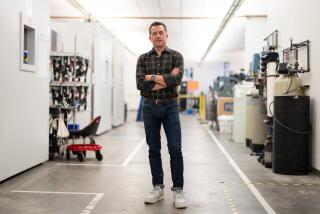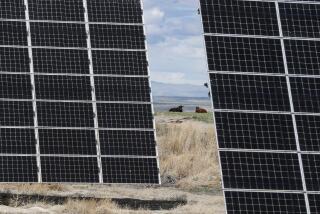International Rectifier heads closer to Infineon Technologies tie-up
For 67 years, International Rectifier Corp. weathered the ups and downs of the global semiconductor industry. In boom years, it opened plants and hired hundreds. In bad years, it did the opposite.
The El Segundo company designs, manufactures and markets power management semiconductors.
Its chips control electricity in industrial, commercial and military equipment. They manipulate electricity to meet the power needs of electronic devices that do not require full, steady streams of power.
The company’s chips do the same for battery-powered equipment, including tablets, satellites and video-game consoles. International Rectifier says its chips help equipment operate more efficiently and with less heat.
Now the company is moving toward a new phase.
International Rectifier agreed in August to be purchased by German rival Infineon Technologies for $40 a share, or about $3 billion. Both boards of directors of the companies have approved the deal.
Oleg Khaykin, International Rectifier’s chief executive, said that the company “will benefit from Infineon’s products and technologies, manufacturing and operational excellence and greater R&D scale.”
Less clear is how the companies’ workforces will mesh. International Rectifier employs more than 4,100 people, with 1,636 in the U.S.
Among its many facilities around the world, four are in California, including its El Segundo headquarters. There is also a fabrication plant in Temecula, an assembly and test facility in San Jose and a design office in Irvine.
International Rectifier was the second power electronics company started by Eric Lidow after World War II. Lidow served as chief executive until 1995 and as board chairman until 2008. Lidow died in 2013.
The latest
On Wednesday, the company reported fiscal 2015 first-quarter financials showing a slight revenue gain to $287 million, up from $270 million a year earlier. Net income rose to $25.9 million, compared with $8.7 million a year earlier.
On Oct. 27, the waiting period under the Hart-Scott-Rodino Antitrust Improvements Act of 1976 expired, marking an important step toward cementing the deal with Infineon. The deal is expected to close late this year or in early 2015.
At least four lawsuits have been filed on behalf of shareholders to block the transaction, contending that the price isn’t high enough.
Accomplishments
International Rectifier has done more than just survive in a tough niche. It has become one of the world’s largest independent manufacturers of power semiconductors.
Lately, the company has been on a roll, with its stock trading near its 52-week high.
In the fiscal year ended June 30, the company bounced back into the black with net income of $58.7 million after posting consecutive net losses of $88.8 million in fiscal 2013 and $55.1 million in fiscal 2012.
Challenges
There may be few business roller coasters scarier than the semiconductor industry.
In 2012, the company began a restructuring program that included closing or resizing some facilities and reducing its sales, administrative, and research and development costs.
In 2009, International Rectifier announced the closure of a California semiconductor plant as part of a plan to slash its global workforce 18%.
In 2008, the company rejected a takeover bid and defeated an effort by rival Vishay Intertechnology Inc. to take control of its board.
The company has also had its share of internal intrigue. In 2007, Lidow’s son, Alex, then the chief executive, left the company and the chief financial officer was fired amid an internal investigation into accounting irregularities. Lawsuits flew between the company and its former CEO; all were settled for undisclosed terms.
Analysts
Of seven analysts that regularly follow International Rectifier, one rates it a buy and six consider it neutral or a hold.
Goldman Sachs upgraded International Rectifier to “neutral” from “sell” on news of the Infineon offer, saying it saw value for the company’s shareholders in the deal.
Twitter: @RonWLATimes







